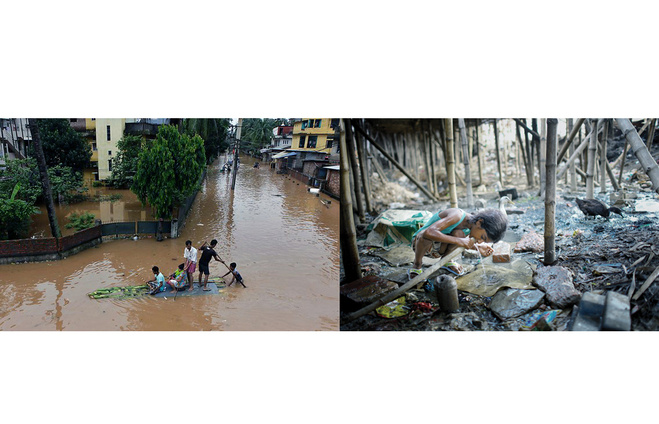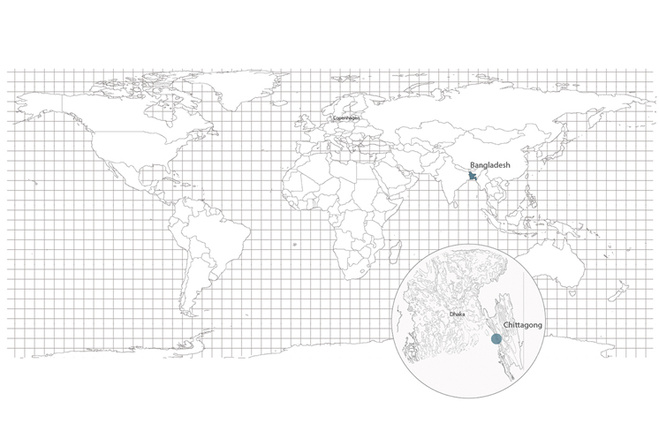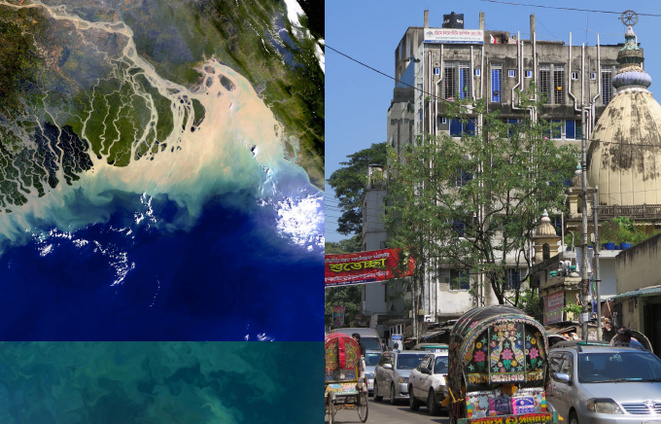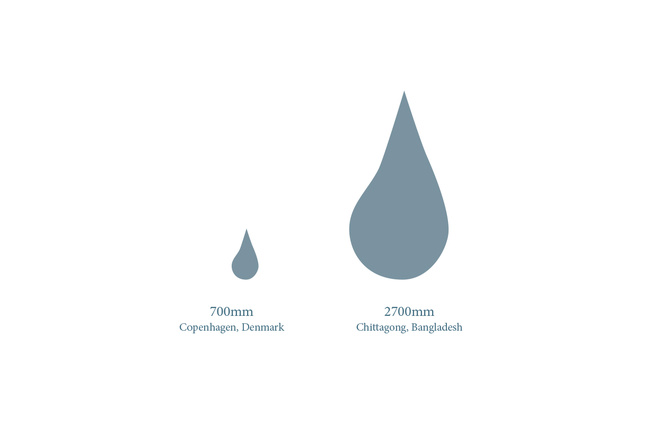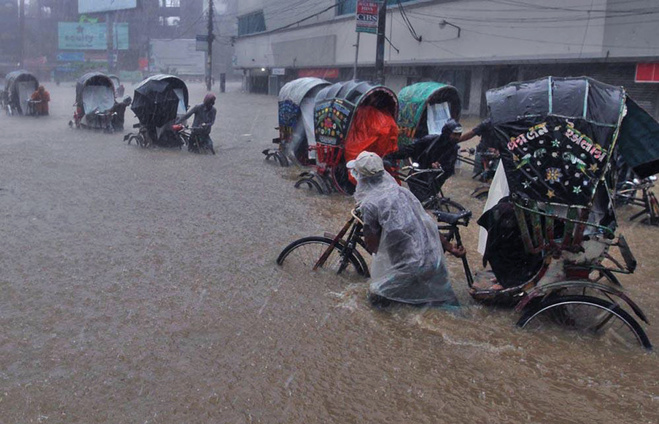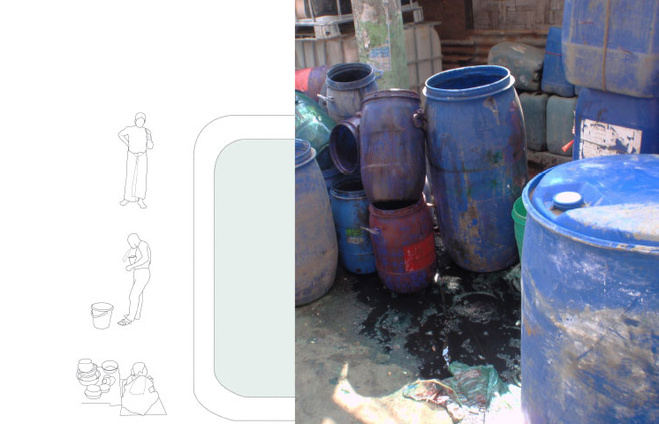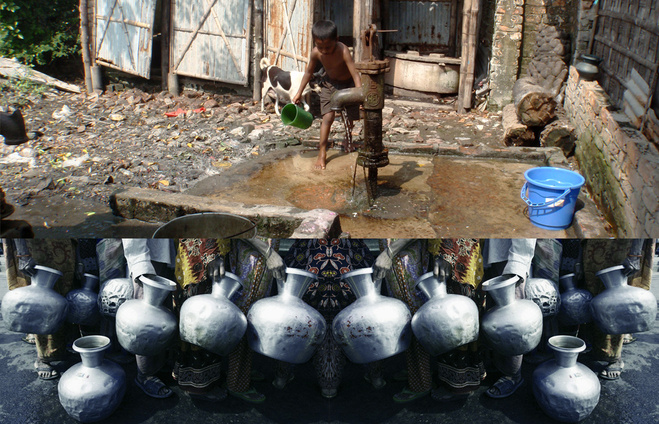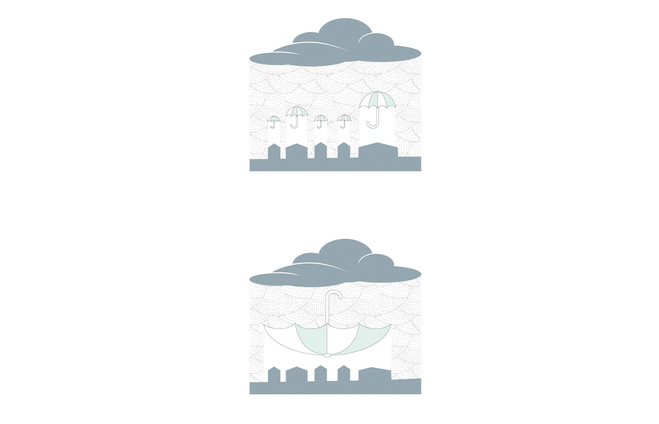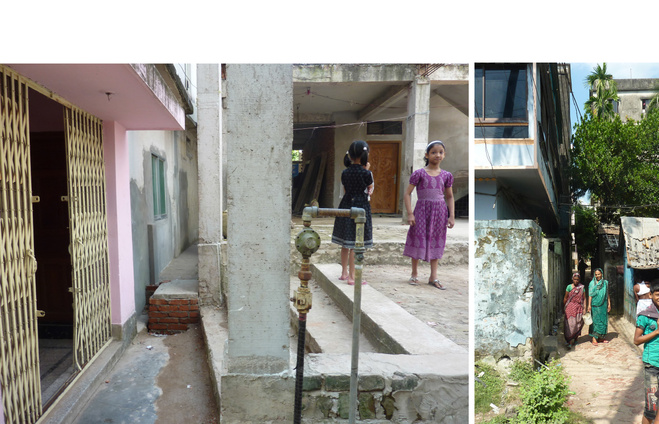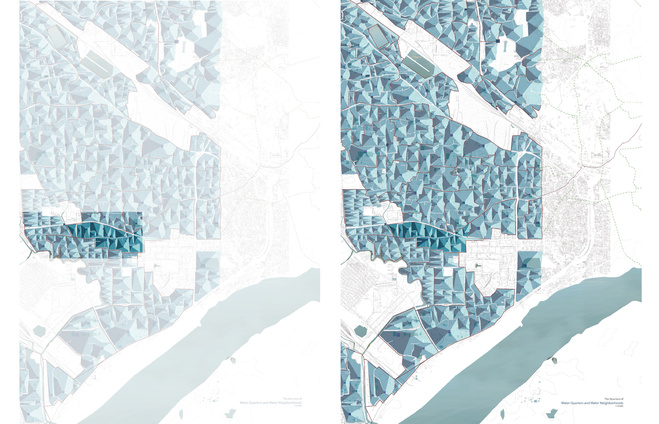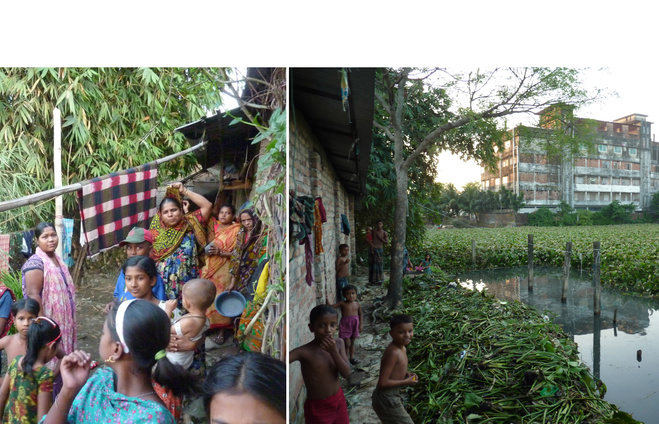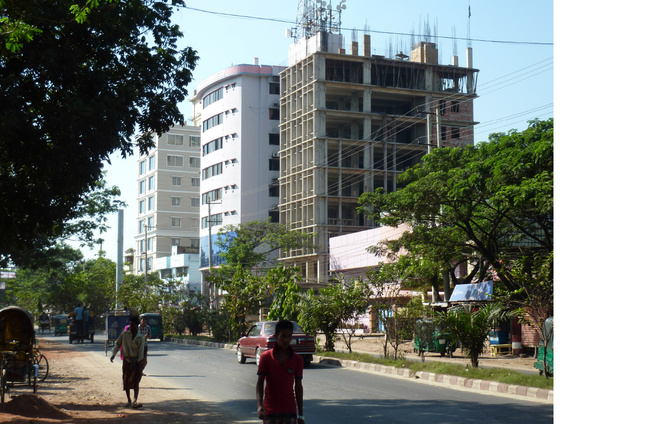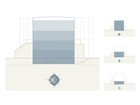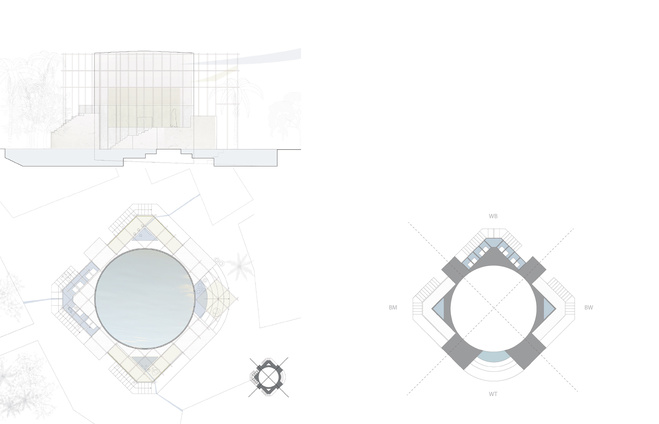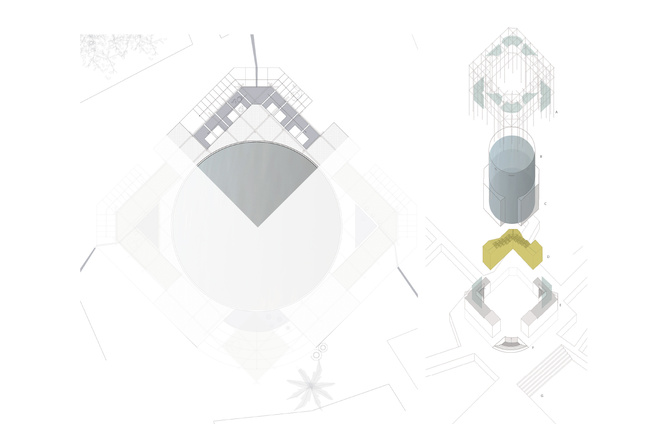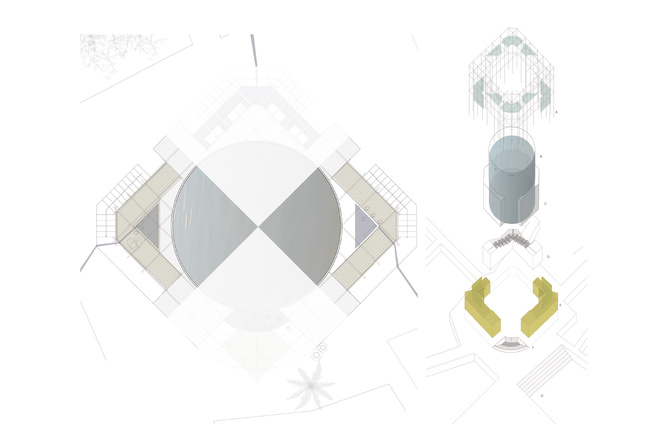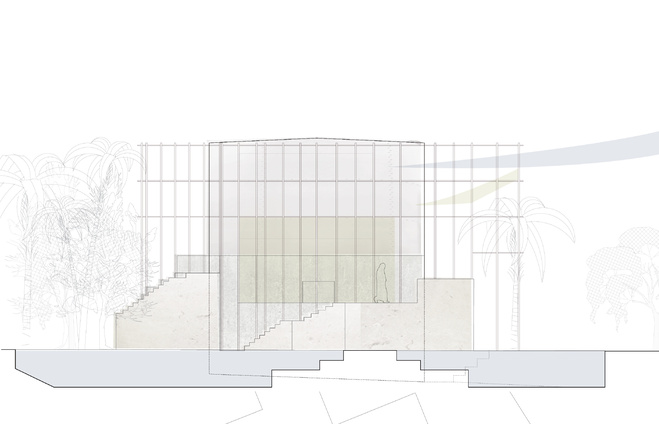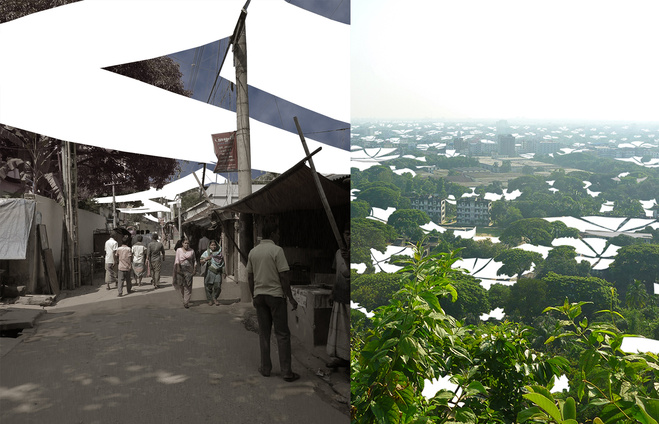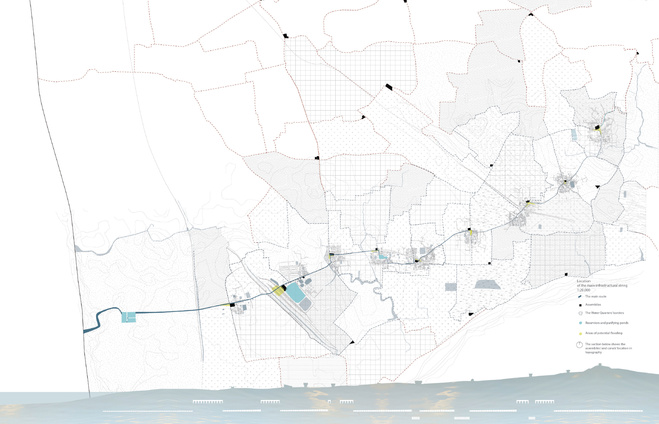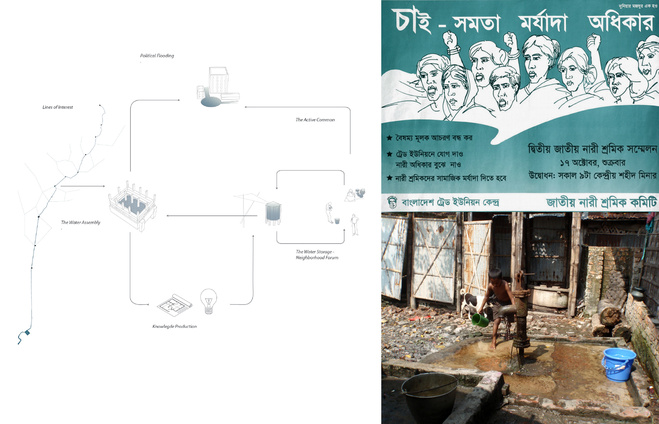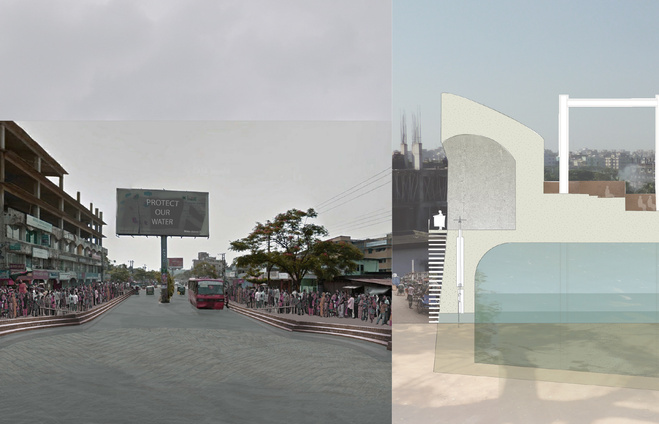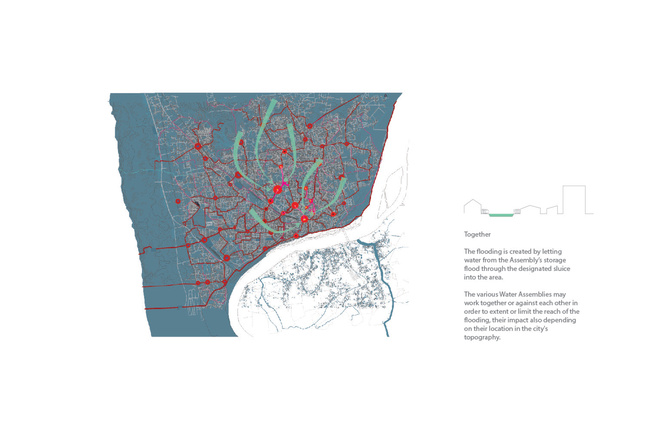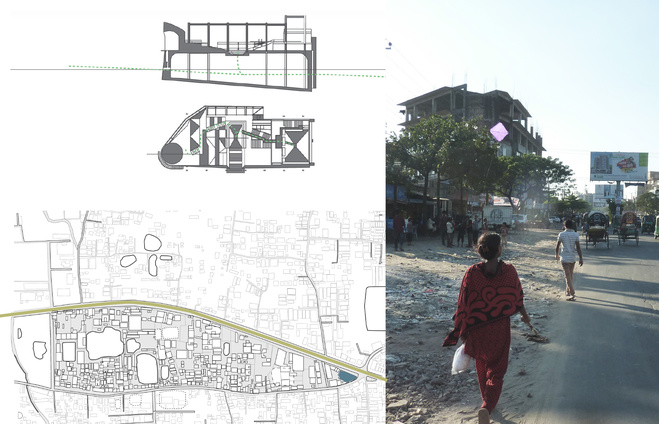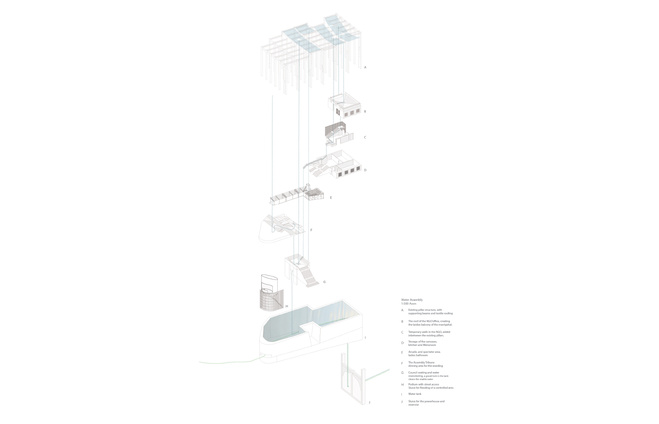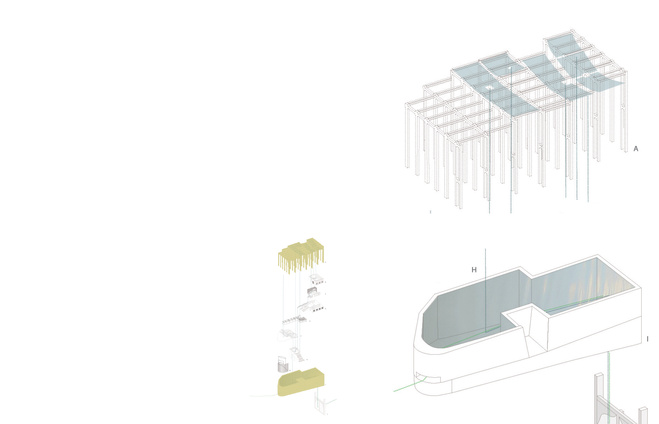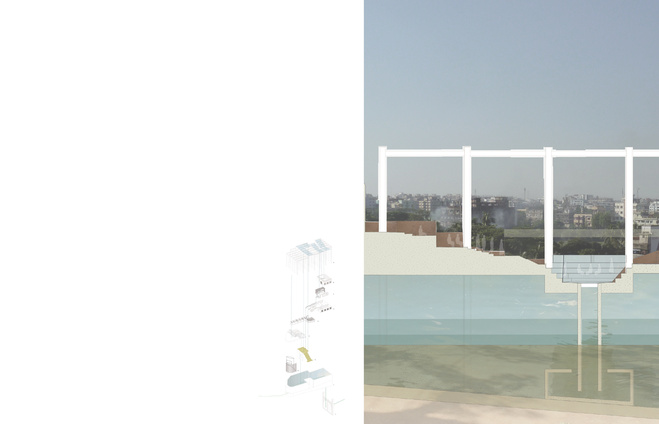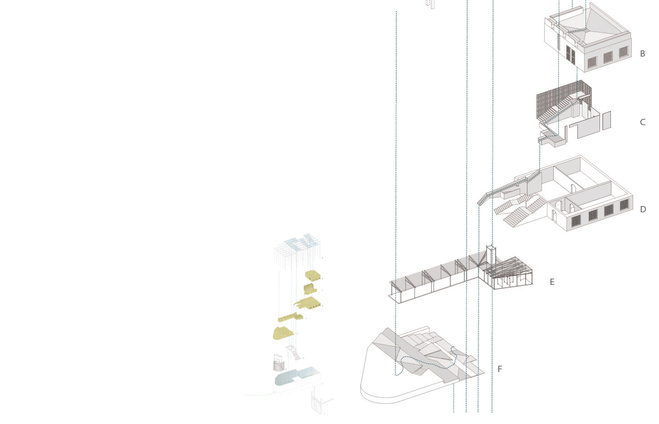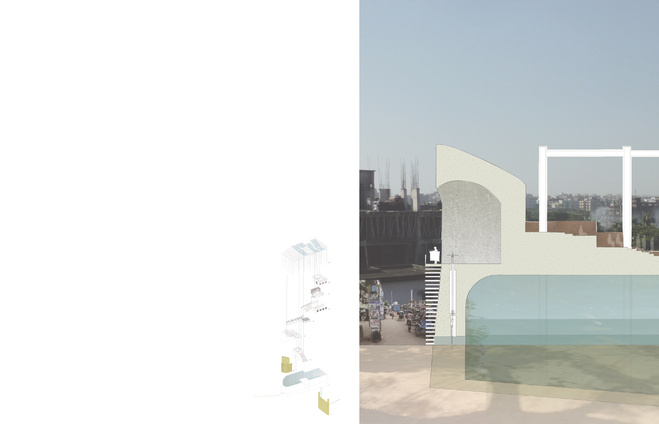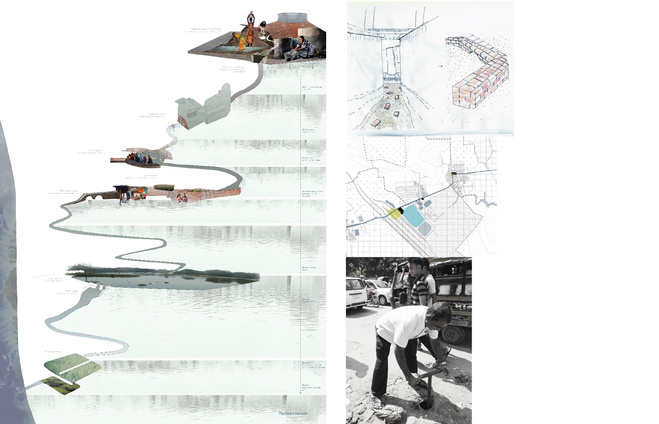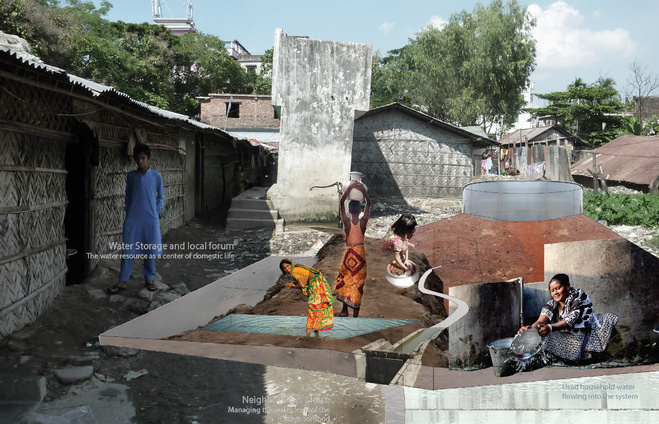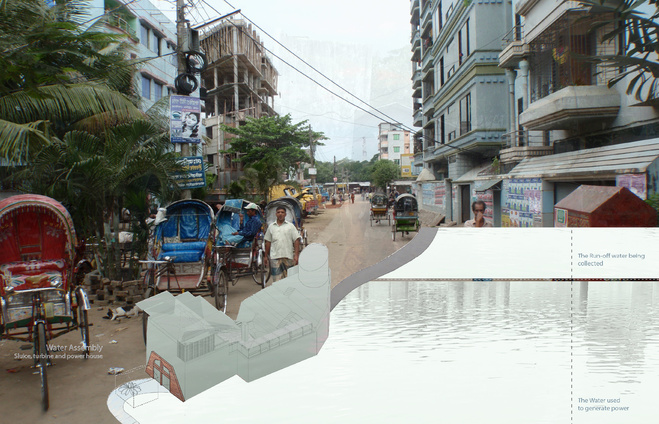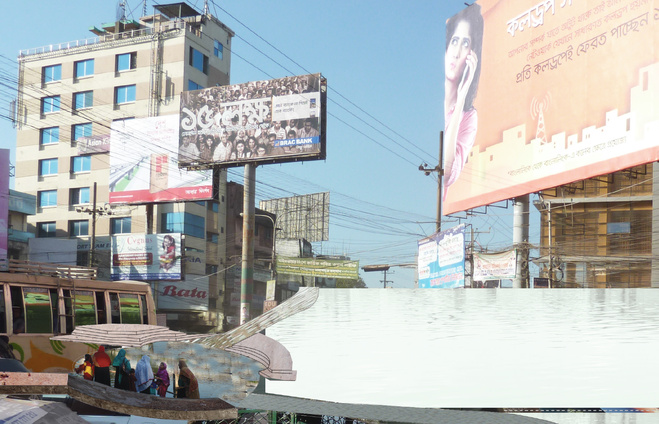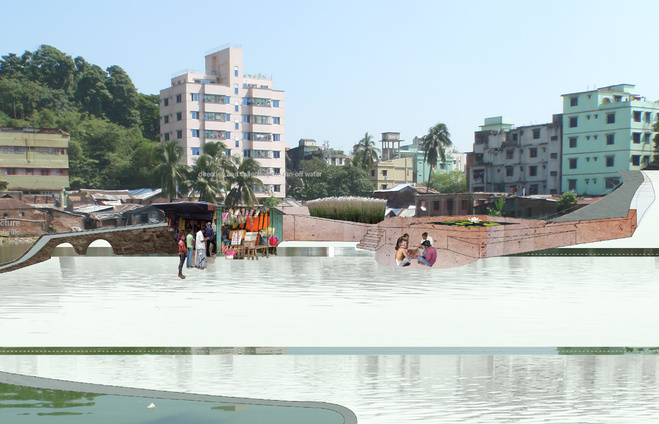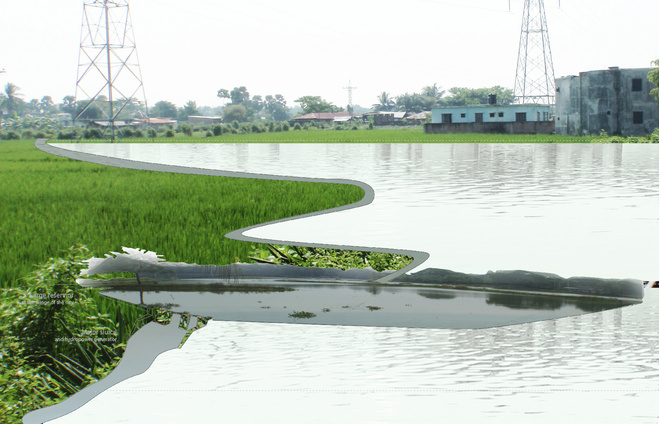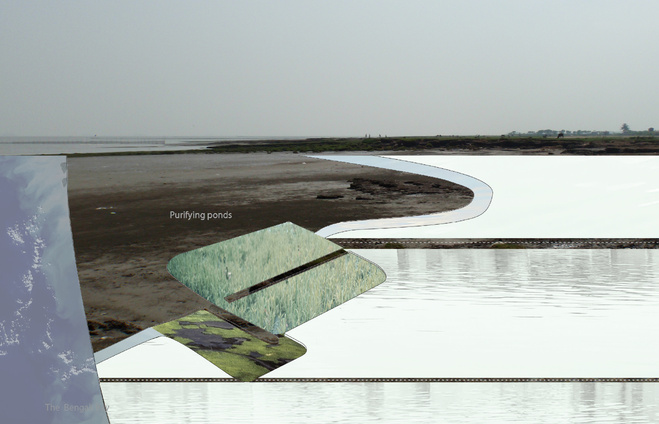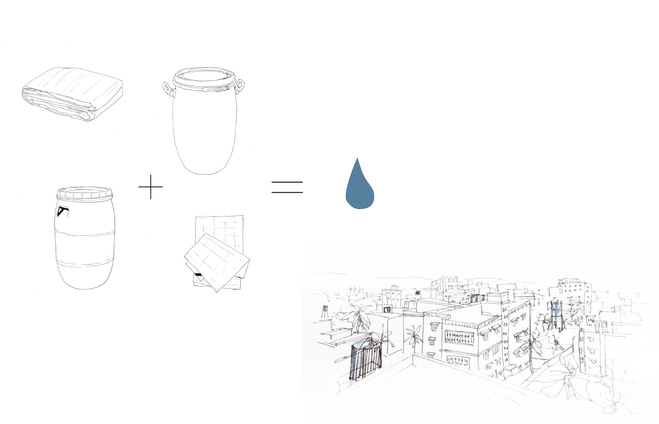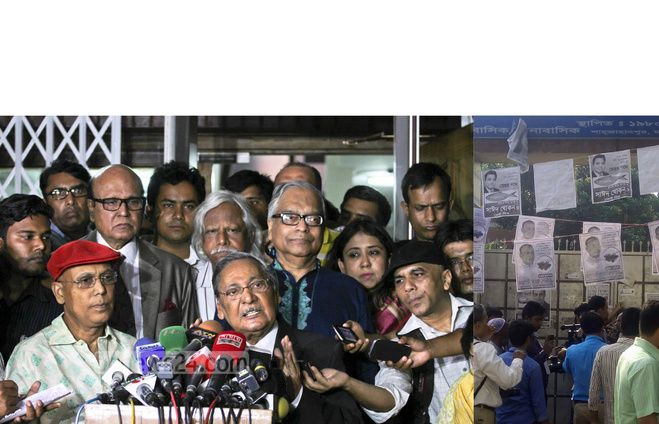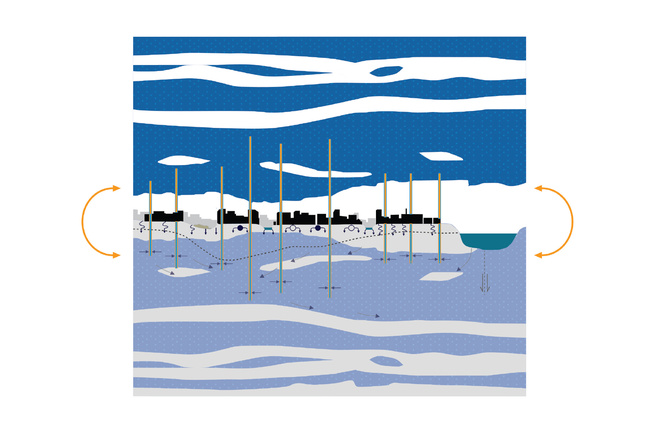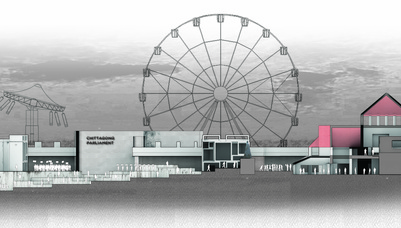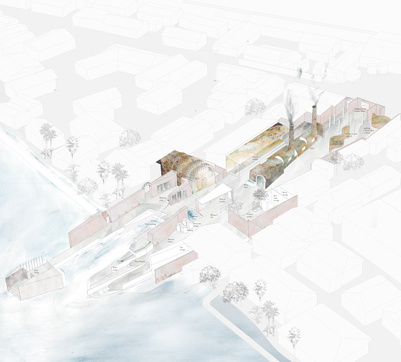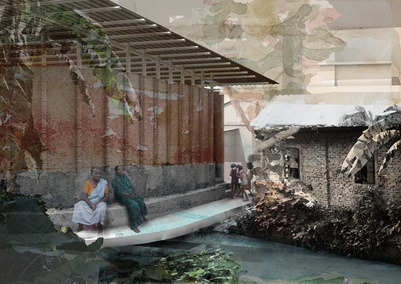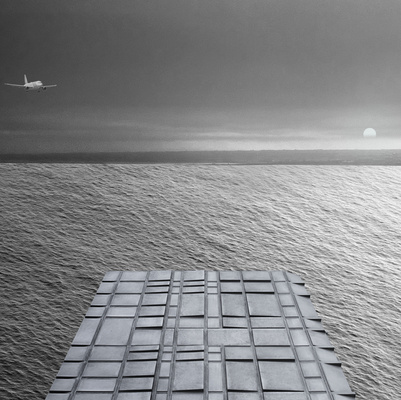A Common Fluent Ground
Project Summary
The city of Chittagong has a surplus of water and an acute need of water.
The project is occupied with the worded paradox of 'the drowned and dehydrated city'- and thus how the rainfall's journey from the sky to the ocean rather than being a problem of often destructive proportions can in fact be reconsidered advantageous for the city of Chittagong, Bangladesh.
The project experiments with how urban planning of a developing country can combine the provision of a vital resource with empowerment for underprivileged communities.
The project's altering of the city fabric makes the seasonal abundance of water ever traceable.
Context of the Paradox
The paradox is a seasonal phenomenon, but its consequenses exists all year around and spreads into the social,financial and political structure of the city.
The City of Chittagong is drowning and dehydrating, because it has both too much and too little water. The paradox is true due to the different forms of water and the ineffective physical divisions between them, which are often transgressed. The different forms of water in; sewers, drains, pipes, ponds, and the like, are mixed when there is too much water, i.e. too much rain.
Whilst having abundance of water the inhabitants of the city struggle with limited access to clean water and poor quality of the accessible water.
The mayority of the citizens of Chittagong live in informal settlements without access to clean water, - only 14% are supplied by the city government. This division results in the use of unregulated and vurnuable water sources, such as hand pumps and ponds. The mixing of the water types makes these unsafe and undrinkable, consequently making clean water an exclusive commodity.
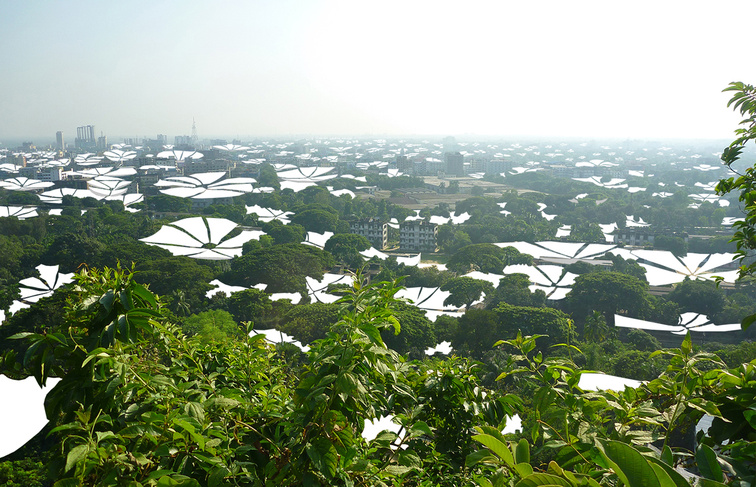
Syntax : Waterways
This project suggests to tackle the paradox from two angles, by leading the unwanted water out of the city with a new infrastructure while harvesting rain for household usage.
A suggested infrastructure which takes advantage of 'The Drowning City', by intervening in the otherwise unwanted water's flow to the ocean with a series of canals, reservoirs and sluices, which potentially can generate power to the city. By working with the existing topography of the city and relating it to the infrastructure of water mangement, exploiting the ways the water currently runs.
The second aspect of the system focuses on 'The Dehydrated City',where rain-harvesting and water storing turns the monsoon into a resource – or even a blessing; thus the rain will have the capacity to provide people with water until the next monsoon. In this way the project is also introduces a reinterpretation of the city's ponds, a widely present rural phenomenon within Chittagong, creating what will be refered to as water-neighborhoods. The third flow of the rain will go into the city's old water infrastructure not only preserving a need for the city's ponds, but also for its rivers, canals and trees.
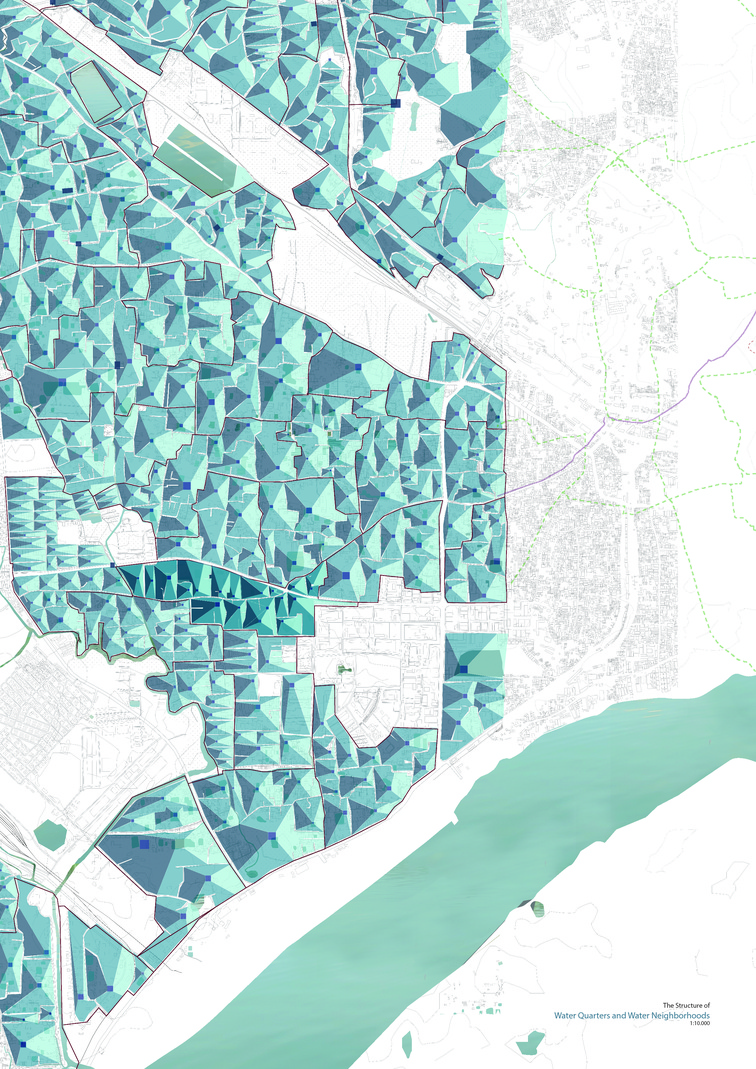
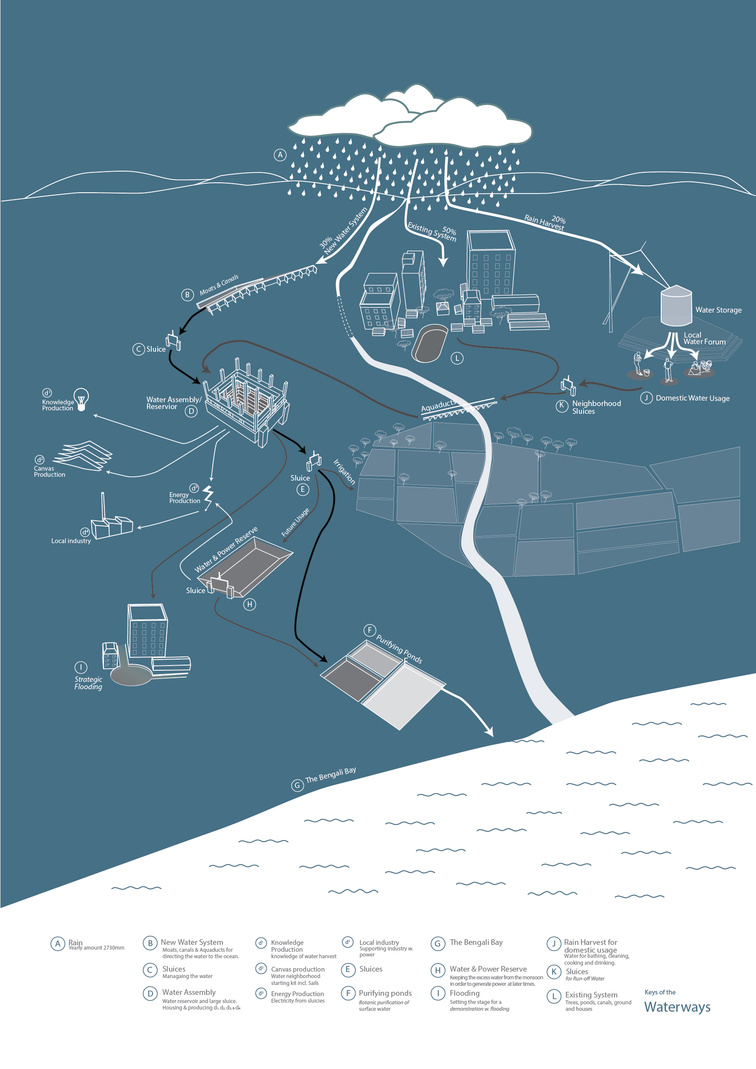

Intention : A Common Ground
The project works on four primary scales; firstly the scale of the city. Secondly the scale of the water Quater. Thirdly the scale of the Water neighborhood and fourthly the scale of the rain storage and capturing.
Additionally all scales come together in order to form a decentralized participatory structure, potentially formed by the need to manage the water and cover basic needs.
As a result of the participatory organization may promote the interest of the social groups without access to clean water.
This booklet 'Waterways' highlightings the projects central actors in order to discuss the challenges concerning the creation of 'A Common Fluent Ground'.
To present the ‘common fluentground’, the text suggests the creation of three commons as part of the proposed project: The Political Common, The Active Common and the Autonomous Common.
Waterways
Locally : Water Neighborhood
In the fully unfolded vision for Chittagong the water neighborhoods covers the city, but the steps leading to this state consistis of works between the different scales and is much relient of the facilitator, the NGO and the establishment of water assemblies.
Since the neighborhoods have various demographics and financial standings; a series of water storage and catchment devices may be developed; From the most primitive of a tarpaulin and plastic barrel to an entire forum accommodating the various activities connected to the daily life with water.
The latter is what has been explored in the site of Shantibag, because it is in the transitional position, that signifies the development of Chittagong as the expanding and developing city it is.
The water storage is developed with attention to the amount of water present in the storage through different times of the year; and for the appropriators to figure out; how and when to priorities its usage. The Water storage works to limit misuse and encourage maintenance with its organization.
The approach is reminiscent to the water storage and conservation system in Rajasthan and Gujarat, where sculptures and steps in the pond, explained how much water was left; and the village inhabitants would then know how and when to limit their consumption.
The supporting walls around the tower grows from the network of walkways, which lead the water to the neighbourhood sluice and the appropriators to the storage. From here the Water Neighborhoods may also have their own sluice, with which they can control when and how much water they release into the infrastructure.
Water Storage
The ground supporting the metal tank, makes room for four different programs in different levels; Washing beds, for washing of cooking utilities and cloths; Women's bathing area, Men's Bathing area and a water tap.
Washing beds; Gaths, they located highest up on the tank, making them unusable when the water level is low. The supporting walls are made from the clay ground mixed with plaster, but detailed with tiles where the wearing activities take place.
The washing beds are organised like steps and with small sluices, in order to keep the water while you are washing and then to let it travel down, down to the moats and canals of the neighbourhood.
The bathing areas each have one large tub, which allow the appropriators to shower.
Both areas are secluded with a bamboo mesh, though the men's are located towards the local forum, recreating the stage, most ponds give. The tubs also have a sluice to keep and reuse the water until it becomes unsarifactory.
The final water point of the water storage is the steps leading down to the water tap. This is the simplest of the water access point;. It is set in the ground and creates an enclosed place, where the appropriates are confronted with each other's usage; when the waterlevel is low. The drips are lead to the surrounding low lying area, beneath the walkways.
The supporting bamboo makes it easy to shield from the sun and provides access to the top holes of the tank. These are used to fill up the tank during the monsoon, by fasting the sail cloth to them.
Yearly the entire neighborhood surrounding the water storage will have to come together in order to prepare for the monsoon.
The Water neighborhood makes for the autonomous common and a new political unity in the city. Several Neighborhoods located next to eachother all leading their surplus water to the same point; form a Water Quarter.
Connector : Water Assembly
The new water infrastructure leads the water from the neighbourhood sluice to the Water Assembly. The water assemblies work with the infrastructure that 'leads the rain to the ocean' but manages the velocity and the amount of water flowing to the ocean with sluices and reservoirs.
The water assemblies' primary program, besides the sluice, is to facilitate discussions on water use and provide housing for the office and storage of the NGO. This particular example of a Water Assembly also provides space for a marriage hall.
The NGO introduces and promotes the idea of the rain-harvest in Chittagong. Mobilizing neighborhoods - providing them the blueprints -, in return, the neighborhoods will have to maintain their part and set up their internal participatory system, creating their own forum in connection with their local water source. A forum in which their opinion on the cases brought up at the Water Assembly can be formulated, discussed and raised.
The assemblies sluice will allow them to keep water in the streets during the monsoon, controlling the temporary over-flooded landscape, allowing for the monsoon to be emphasized as a seasonal urban ritual.
The assemblies have a second sluice, allowing them to flood a designated area.
Demonstrations are used to showcase public opinion and are formed by a mass group or a collection of groups, meaning the controlled flooding, becomes the spatial intervention of the opposition/opinion of serveral the water assemblies.
The Assemblies are interconnected through the infrastructure and may work togther or against eachother to amplify or limit the effect of the controlled flooding. By either opening their sluice or closeing it, depending on their position in the city topography.
The specific Water assembly in Shantibag is a transformation of an existing building. Which have a very prominent position next to the central Agrabad Access Road. As all the assemblies have a prominent position in relation to topography or political locations.
Keeping and supporting the existing pillars and excavating it to allow for a small reservior to take over the basement, ground and second level of the building. The deck above the tank holds the programs of the water assembly.
The transformation allows the building to contain; both the function of a note in the water infrastrcuture and the function of a central political point.
The pillars allow for a textile roof to be streched out and direct the water to specific points and whiles shielding the sun.
A large central staircase leads to the council area, while taking a seat here or moving further up, one can observe the water level in the well. It shows the Assemblies potential to act; to either flood the designated area or generate electricity.
One side of the council area is the programmed sites, with Ngo' offices, bathrooms, storage and a womenss balcony for weddings. The water travels down through and above the different programs which allow the rain to fill up the tank in addition to the surface water.
The other side is designed as a public area as well as the tribune for the assemblies that takes place quarterly.
The Assembly has two sluices, one to lead the water to the infrastructure and can generate power and one which can create a flooding in a controlled area.
The existing tower, houses the podium, and also houses the control of the designated sluice.
City : Water Network
The architectural interventions are modifications of behaviors, actions or movements already present in Chittagong.
For example the lager reservoirs used to store monsoon water and generate power from, have taken form by emphazising the places in the city, where the water already collects. Additionally the moats, dams and walkways that lead the water to the new infrastructure originate from the man drilling a hole to the communal sewer and the bricks laid out to create a stable ground during the monsoon.
The water infrastructure consists of moats, canals, aquaducts, reservoirs and sluices, which exploits the city's road network and topography. As mentioned it is a series of modification of the city's inherent potential.
The simplification of the water's way from the neighborhood water tank to the sea:
From the domestic usage to the neighborhood sluice,
from the local sluice to the water assembly and its sluice,
Flowing the water further down to the designated demonstration or celebration plaza and
-onward where its supporting structure creates pocket squares, benches and storefronts before moving above the rails.
While the water travels through the new infrastructure it is simplisticly cleaned by plants of the pragmatis and water lilies families. These plants grow controlled by cages on the surface of the water flow.
Further along the water flow meets the ground again is lead to a large reservior on the brink of the city
- through the large sluice and then to its last pause, just near the beach, where the water is clean with both plant and gravel ponds, taking out the worst pollution, before releasing out into the ocean.
Time: Vision and Setting
The creation of A Common Fluent Ground works in between the pragmatic and the speculative as a necessity, since each part of a new water system in Chittagong cannot be seen as an isolated incidences, they are all connected through the finical, social and political layers of the city.
This penduling is done so, due to the abilities of the speculative, it can paint the bigger picture and allows for one to see the possibilities before the hindrances.
A speculative allow for visions to take form, these can challenge the way we perceive, in this case, the destructive forces of rain. - the speculative opens the possibility that the rain is a benefit in this specific context.
To keep the speculations relevant in this project, it needs to be grounded in the pragmatic at specific points. The reality of the context questioning the visions have been the driver and developer of the project in addition to; following the water.
Working with a material which is so relatable on one side and something as abstract on the other, water, the speculative needs to meet reality too keep it relevant and believable.
How this penduling between pragmatic questioning and speculative ideas, the project finishes of with a description of the issues concerning a realization:
The water infrastructure leads the water out of the city, limits flooding and can generate power to the city, therefor it is likely that the government would initiate this work for example in cooperation with the World Bank, which works to prevent flooding throughout Asia.
But since these autonomous water assemblies and their sluice are able to interrupt the infrastructure of the city, not just the water network but also close off roads, they are likely to be oppressed by the city government or others whom's interest might be treathen.
What these Assemblies can do on another level is to initiate this power-struggle concerning, who has the control of leading the water out of the city, potentially making it more efficient.
Due to the treat these assemblies might pose and the political hindrance, the realization would be initiated in the other end of the spectrum, with rain-harvesting.
A political starting point for the realization of the project would be to develop the the rain harvesting system with the most basic means of the neighborhoods, -doing so to ensure the new water system expands from the ground up. This could be done in the way many NGO's work, starting with one defined neighborhood; but then additionally allowing for the idea to expand through a platform, the Water-Assembly.
This project follows the water and the water will inevitably continue to travel down stream and evaporate just to become rain again. This cycle of water is a fitting metaphor for the workings of this project. Each suggestion can be reevaluated and developed further in order for Chittagong to be a city which takes advantage of the link between urban planning and political organization by turning the destructive force of the rain into an advantage.


